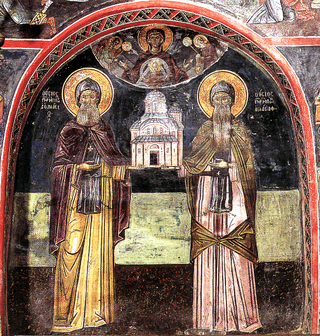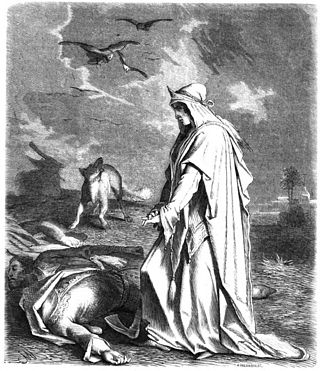This is an alphabetical index of people, places, things, and concepts related to or originating from the Byzantine Empire. Feel free to add more, and create missing pages. You can track changes to the articles included in this list from here.
David Megas Komnenos was the last Emperor of Trebizond from 1460 to 1461. He was the third son of Emperor Alexios IV of Trebizond and Theodora Kantakouzene. Following the fall of Trebizond to the Ottoman Empire, he was taken captive with his family to the Ottoman capital, Constantinople, where he and his sons and nephew were executed in 1463.

The Empire of Trebizond, or Trapezuntine Empire, was a monarchy and one of three successor rump states of the Byzantine Empire, along with the Despotate of the Morea and the Principality of Theodoro, that flourished during the 13th through to the 15th century, consisting of the far northeastern corner of Anatolia and the southern Crimea. The empire was formed in 1204 with the help of the Georgian queen Tamar after the Georgian expedition in Chaldia and Paphlagonia, commanded by Alexios Komnenos a few weeks before the sack of Constantinople. Alexios later declared himself Emperor and established himself in Trebizond. Alexios and David Komnenos, grandsons and last male descendants of deposed Emperor Andronikos I Komnenos, pressed their claims as "Roman emperors" against Byzantine Emperor Alexios V Doukas. The later Byzantine emperors, as well as Byzantine authors, such as George Pachymeres, Nicephorus Gregoras and to some extent Trapezuntines such as John Lazaropoulos and Basilios Bessarion, regarded the emperors of Trebizond as the "princes of the Lazes", while the possession of these "princes" was also called Lazica. Thus from the point of view of the Byzantine writers connected with the Laskaris and later with the Palaiologos dynasties, the rulers of Trebizond were not emperors.

Mangup also known as Mangup Kale is a historic fortress in Crimea, located on a plateau about 13 kilometres due east of Sevastopol.
Alexios I Megas Komnenos or Alexius I Megas Comnenus was, with his brother David, the founder of the Empire of Trebizond and its ruler from 1204 until his death in 1222. The two brothers were the only male descendants of the Byzantine Emperor Andronikos I, who had been dethroned and killed in 1185, and thus claimed to represent the legitimate government of the Empire following the conquest of Constantinople by the Fourth Crusade in 1204. Although his rivals governing the Nicaean Empire succeeded in becoming the de facto successors, and rendered his dynastic claims to the imperial throne moot, Alexios' descendants continued to emphasize both their heritage and connection to the Komnenian dynasty by later referring to themselves as Megas Komnenos.
The House of Kantakouzenos, Latinized as Cantacuzenus and anglicized as Cantacuzene, was one of the most prominent Greek noble families of the Byzantine Empire in the last centuries of its existence. The family was one of the Empire's wealthiest and provided several prominent governors and generals, as well as two Byzantine emperors. The Kantakouzenoi intermarried extensively with other Byzantine noble families such as the Palaiologoi, the Philanthropenoi, the Asen, and the Tarchaneiotes. The feminine form of the name is Kantakouzene, Latinized as Cantacuzena.
Alexios IV Megas Komnenos or Alexius IV, Emperor of Trebizond from 5 March 1417 to 26 April 1429. He was the son of Emperor Manuel III and Gulkhan-Eudokia of Georgia.

Alexios III Megas Komnenos, or Alexius III, was Emperor of Trebizond from December 1349 until his death. He is perhaps the best-documented ruler of that country, and his reign is distinguished by a number of religious grants and literary creations.

The Principality of Theodoro, also known as Gothia or the Principality of Theodoro-Mangup, was a Greek principality in the southern part of Crimea, specifically on the foothills of the Crimean Mountains. It represented one of the final rump states of the Eastern Roman Empire and the last territorial vestige of the Crimean Goths until its conquest by the Ottoman Empire by the Ottoman Serb Gedik Ahmed Pasha in 1475. Its capital was Doros, also sometimes called Theodoro and now known as Mangup. The state was closely allied with the Empire of Trebizond.

Jovan Uroš Nemanjić or John Ouresis Doukas Palaiologos or Joasaph of Meteora, was the ruler of Thessaly from c. 1370 to c. 1373, retiring as a monk for the next half century thereafter. He died in 1422 or 1423.

John IV Megas Komnenos was Emperor of Trebizond from 1429 until his death. He was a son of Emperor Alexios IV of Trebizond and Theodora Kantakouzene.
Helena Kantakouzene was the Empress consort of John V Palaiologos in the Byzantine Empire.
Anna Philanthropene was the second Empress consort of Manuel III of Trebizond.
Theodora Kantakouzene Megale Komnene was the Empress consort of Alexios IV of Trebizond. Said to be very beautiful, according to the chronicle of Laonikos Chalkokondyles, she was accused by her son, John Megas Komnenos, of having an affair with the protovestiarios of the court of Trebizond; however, other accounts describe her as a faithful and loving wife, who kept the peace between Alexios and his sons. In either case, during her lifetime their son John fled to Georgia and did not return until after Theodora's death.

Helena Kantakouzene was the second wife of David of Trebizond, the last Emperor of Trebizond.
Theodore Gabras was a Byzantine governor in the Pontus who was involved in a minor unsuccessful rebellion against the Emperor Alexios I Komnenos around the year 1091. Theodore Gabras is an Eastern Orthodox martyr whose feast day is celebrated on 2 October.
Eudokia Megale Komnene, was a Trapezuntine noblewoman and a member of the powerful Byzantine Komnenos dynasty as a daughter of Emperor Alexios III of Trebizond.
Gabras or Gavras feminine form Gabraina (Γάβραινα), is the name of an important Byzantine aristocratic family which became especially prominent in the late 11th and early 12th centuries as the semi-independent and quasi-hereditary rulers of Chaldia.
George Palaiologos Kantakouzenos was a Byzantine aristocrat, a member of the Kantakouzenos family, and adventurer. He is also known by the Turkish nickname Sachatai, which he earned in the service of the Despot Constantine early in his military career.
Alexander Megas Komnenos, also recorded as Skantarios, was co-emperor of the Empire of Trebizond alongside his elder brother John IV Megas Komnenos c. 1451–1459. Alexander was the second son of the Trapezuntine emperor Alexios IV Megas Komnenos. John was exiled after a failed rebellion against their father in c. 1426, and Alexios made Alexander the designated heir. John returned to Trebizond in early 1429 and seized the throne, killing Alexios and forcing Alexander into exile.